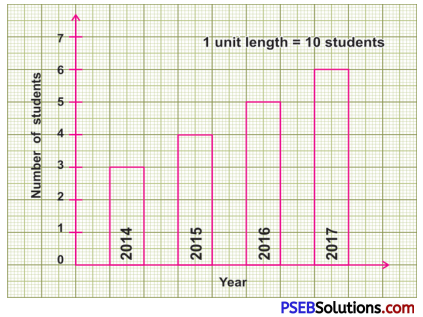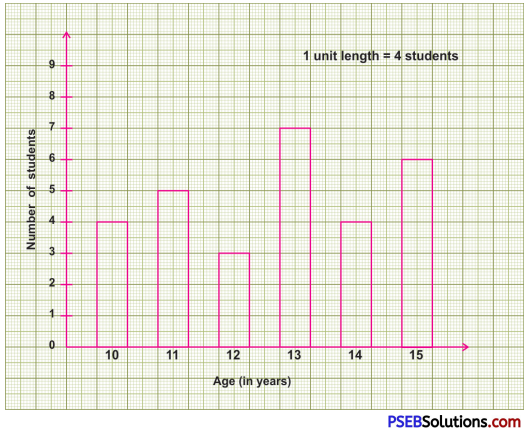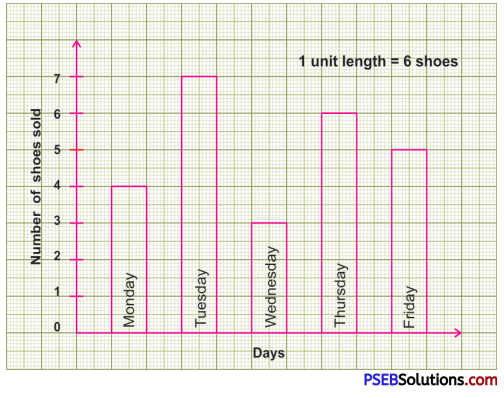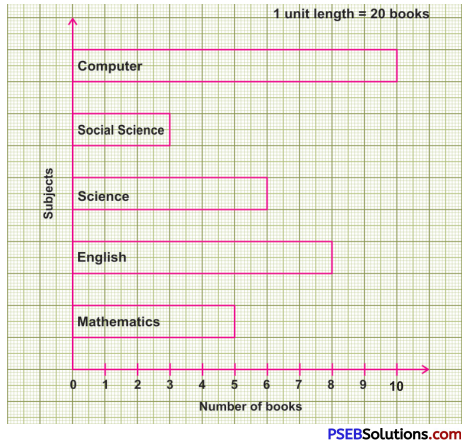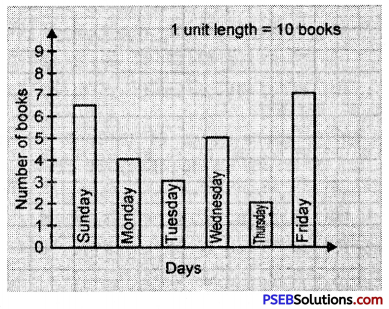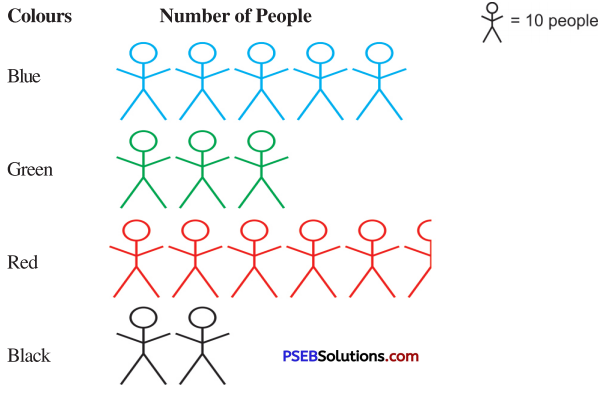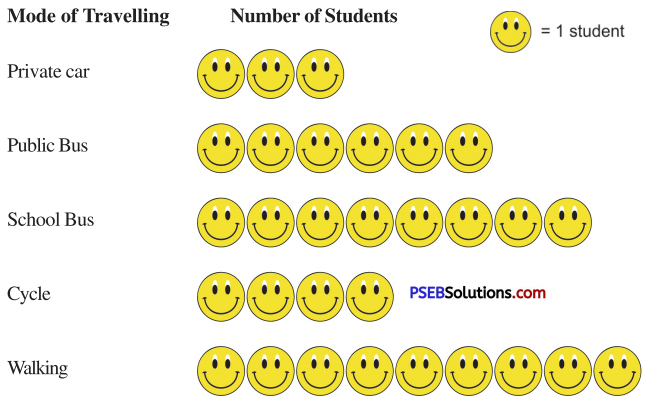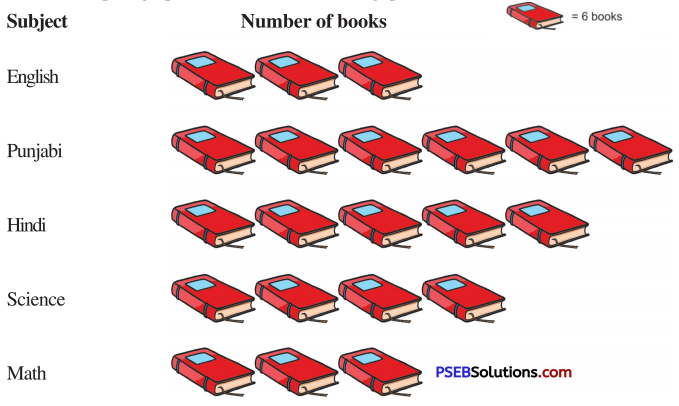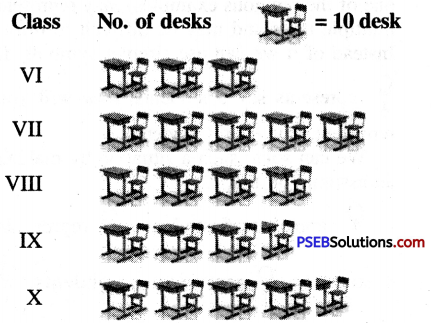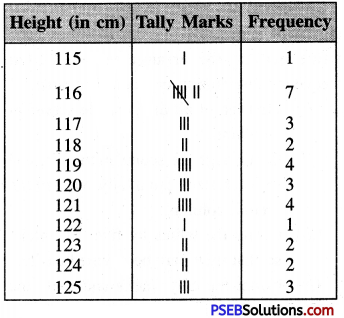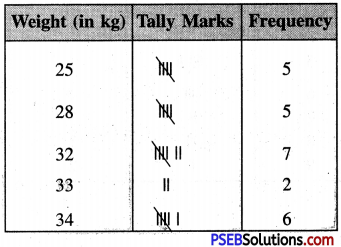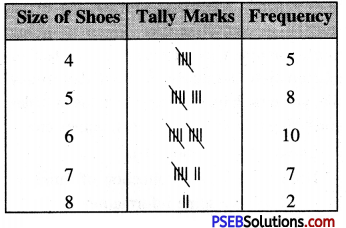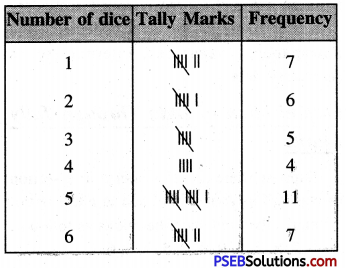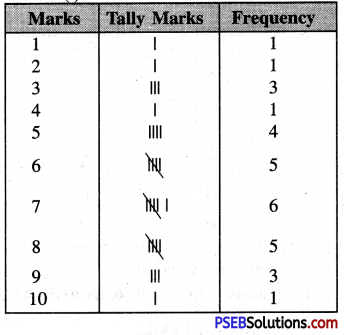Punjab State Board PSEB 6th Class Punjabi Book Solutions Chapter 5 ਪਿੰਡ ਦਾ ਮੋਹ Textbook Exercise Questions and Answers.
PSEB Solutions for Class 6 Punjabi Chapter 5 ਪਿੰਡ ਦਾ ਮੋਹ
1. ਬਹੁਵਿਕਲਪੀ ਪ੍ਰਸ਼ਨ
ਪ੍ਰਸ਼ਨ-ਠੀਕ ਉੱਤਰ ਅੱਗੇ ਸਹੀ (✓) ਦਾ ਨਿਸ਼ਾਨ ਲਾਓ :
(i) ਗੁਰਮੀਤ ਸਿੰਘ ਨੇ ਕਿਹੜਾ ਮੋਹ ਨਹੀਂ ਸੀ ਛੱਡਿਆ ?
(ਉ) ਪੈਸੇ ਦਾ ਮੋਹ
ਸ਼ਹਿਰ ਦਾ ਮੋਹ
(ਇ) ਪਿੰਡ ਦਾ ਮੋਹ ।
ਉੱਤਰ :
(ਇ) ਪਿੰਡ ਦਾ ਮੋਹ । ✓
(ii) ਜੋਤੀ ਕਿਉਂ ਖੁਸ਼ ਸੀ ?
(ਉ) ਪਿੰਡ ਜਾਣ ਕਰਕੇ
(ਅ) ਨਵੇਂ ਕੱਪੜੇ ਲੈਣ ਕਰਕੇ
(ਇ) ਸਾਈਕਲ ਖ਼ਰੀਦਣ ਕਰਕੇ ।
ਉੱਤਰ :
(ਇ) ਸਾਈਕਲ ਖ਼ਰੀਦਣ ਕਰਕੇ । ✓
![]()
(iii) ‘‘ਬਈ, ਗੁਰਮੀਤ ਸਿੰਘ ਵਰਗੇ ਪੁੱਤਰ ਤਾਂ ਘਰ-ਘਰ ਜੰਮਣ’ ਇਹ ਸ਼ਬਦ ਕਿਸ ਨੇ ਕਹੇ ?
(ਉ) ਜਾਗਰ ਸਿੰਘ
(ਅ) ਗੁਰਨਾਮ ਸਿੰਘ
(ਈ) ਬਿਸ਼ਨ ਸਿੰਘ ।
ਉੱਤਰ :
(ਅ) ਗੁਰਨਾਮ ਸਿੰਘ ✓
(iv) ਕਰਤਾਰ ਕੌਰ ਨੇ ਖਾਣ ਲਈ ਕੀ ਬਣਾਇਆ ਹੋਇਆ ਸੀ ?
(ੳ) ਮੱਕੀ ਦੀ ਰੋਟੀ ਅਤੇ ਸਰੋਂ ਦਾ ਸਾਗ
(ਅ) ਖੀਰ
(ਈ) ਸੇਵੀਆਂ !
ਉੱਤਰ :
(ੳ) ਮੱਕੀ ਦੀ ਰੋਟੀ ਅਤੇ ਸਰੋਂ ਦਾ ਸਾਗ ✓
(v) ਸੌਣ ਤੋਂ ਪਹਿਲਾਂ ਬੱਚਿਆਂ ਨੇ ਕੀ ਕੀਤਾ ?
(ਉ) ਟੀ.ਵੀ. ਦੇਖਿਆ।
(ਅ) ਬਾਤਾਂ ਸੁਣੀਆਂ।
(ਈ) ਕੰਪਿਊਟਰ-ਖੇਡਾਂ ਖੇਡੀਆਂ ।
ਉੱਤਰ :
(ਅ) ਬਾਤਾਂ ਸੁਣੀਆਂ। ✓
2. ਛੋਟੇ ਉੱਤਰ ਵਾਲੇ ਪ੍ਰਸ਼ਨ
ਪ੍ਰਸ਼ਨ 1.
ਗੁਰਮੀਤ ਸਿੰਘ ਨੂੰ ਪਿੰਡ ਕਿਉਂ ਛੱਡਣਾ ਪਿਆ ਸੀ ?
ਉੱਤਰ :
ਨੌਕਰੀ ਸ਼ਹਿਰ ਵਿਚ ਹੋਣ ਕਾਰਨ ।
ਪ੍ਰਸ਼ਨ 2.
ਸਕੂਲ ਵਿੱਚ ਛੁੱਟੀਆਂ ਕਿਉਂ ਹੋਈਆਂ ਸਨ ?
ਉੱਤਰ :
ਸਕੂਲ ਦੇ ਬੱਚਿਆਂ ਦੁਆਰਾ ਖੇਡਾਂ ਵਿਚ ਮੈਡਲ ਜਿੱਤਣ ਕਾਰਨ ।
![]()
ਪ੍ਰਸ਼ਨ 3.
ਜਾਗਰ ਸਿੰਘ ਨੇ ਫ਼ਤਿਹ ਦਾ ਜਵਾਬ ਦਿੰਦਿਆਂ ਗੁਰਮੀਤ ਸਿੰਘ ਨੂੰ ਕੀ ਕਿਹਾ ?
ਉੱਤਰ :
ਉਸਨੇ ਗੁਰਮੀਤ ਸਿੰਘ ਨੂੰ ਅਸ਼ੀਰਵਾਦ ਦਿੰਦਿਆਂ ਉਸਦਾ ਹਾਲ-ਚਾਲ ਪੁੱਛਿਆ
ਪ੍ਰਸ਼ਨ 4.
ਅਗਲੀ ਸਵੇਰ ਗੁਰਮੀਤ ਸਿੰਘ ਨੇ ਬੱਚਿਆਂ ਨੂੰ ਜਲਦੀ ਕਿਉਂ ਉਠਾਇਆ ?
ਉੱਤਰ :
ਕਿਉਂਕਿ ਉਨ੍ਹਾਂ ਸਵੇਰੇ ਨੌਂ ਵਜੇ ਤੋਂ ਪਹਿਲਾਂ ਮੁਹਾਲੀ ਪਹੁੰਚਣਾ ਸੀ ।
ਪ੍ਰਸ਼ਨ 5.
ਬਿਸ਼ਨ ਸਿੰਘ ਗੁਰਮੀਤ ਸਿੰਘ ਅਤੇ ਉਸ ਦੇ ਪਰਿਵਾਰ ਨੂੰ ਕਿੱਥੇ ਛੱਡਣ ਗਿਆ ?
ਉੱਤਰ :
ਬੱਸ ਅੱਡੇ ਤੱਕ ।
3. ਸੰਖੇਪ ਉੱਤਰ ਵਾਲੇ ਪ੍ਰਸ਼ਨ
ਪ੍ਰਸ਼ਨ 1.
ਬਿਸ਼ਨ ਸਿੰਘ ਨੇ ਪਿੰਡ ਦੇ ਟੋਭੇ ਬਾਰੇ ਬੱਚਿਆਂ ਨੂੰ ਕੀ ਦੱਸਿਆ ?
ਉੱਤਰ :
ਬਿਸ਼ਨ ਸਿੰਘ ਨੇ ਪਿੰਡ ਦੇ ਟੋਭੇ ਬਾਰੇ ਦੱਸਿਆ ਕਿ ਇਸ ਵਿਚ ਬਰਸਾਤ ਦਾ ਪਾਣੀ ਇਕੱਠਾ ਹੁੰਦਾ ਹੈ, ਜੋ ਕਿ ਪਸ਼ੂਆਂ ਦੇ ਪੀਣ ਤੇ ਨਹਾਉਣ ਦੇ ਕੰਮ ਆਉਂਦਾ ਹੈ ।
ਪ੍ਰਸ਼ਨ 2.
ਗੁਰਨਾਮ ਸਿੰਘ ਨੇ ਗੁਰਮੀਤ ਸਿੰਘ ਦੀ ਤਾਰੀਫ਼ ਕਿਵੇਂ ਕੀਤੀ ?
ਉੱਤਰ :
ਗੁਰਨਾਮ ਸਿੰਘ ਨੇ ਗੁਰਮੀਤ ਸਿੰਘ ਦੀ ਤਾਰੀਫ਼ ਕਰਦਿਆਂ ਕਿਹਾ ਕਿ ਉਸ ਵਰਗੇ ਪੁੱਤਰ ਤਾਂ ਘਰ-ਘਰ ਜੰਮਣੇ ਚਾਹੀਦੇ ਹਨ, ਜਿਸਨੂੰ ਭਾਵੇਂ ਸ਼ਹਿਰ ਗਿਆਂ ਦਸ ਸਾਲ ਹੋ ਗਏ ਹਨ, ਪਰ ਉਸਨੇ ਪਿੰਡ ਦਾ ਮੋਹ ਨਹੀਂ ਛੱਡਿਆ ਤੇ ਪਿੰਡ ਆਉਂਦਾ ਰਹਿੰਦਾ ਹੈ । ਨਾਲ ਹੀ ਉਹ ਪਿੰਡ ਦੇ ਸਾਰੇ ਵੱਡਿਆਂ-ਬਜ਼ੁਰਗਾਂ ਨੂੰ ਮਿਲ ਕੇ ਜਾਂਦਾ ਹੈ !
ਪ੍ਰਸ਼ਨ 3.
ਖੇਤਾਂ ਵਿਚ ਗੇੜਾ ਮਾਰਨ ਤੋਂ ਬਾਅਦ ਬਿਸ਼ਨ ਸਿੰਘ ਨੇ ਬੱਚਿਆਂ ਨੂੰ ਕੀ ਦਿਖਾਇਆ ?
ਉੱਤਰ :
ਖੇਤਾਂ ਵਿਚ ਗੇੜਾ ਮਾਰਨ ਤੋਂ ਮਗਰੋਂ ਬਿਸ਼ਨ ਸਿੰਘ ਨੇ ਉਨ੍ਹਾਂ ਨੂੰ ਪਿੰਡ ਦਾ ਗੁਰਦੁਆਰਾ, ਧਰਮਸ਼ਾਲਾ ਤੇ ਖੁਹ ਦਿਖਾਏ ।
ਪ੍ਰਸ਼ਨ 4.
ਕਰਤਾਰ ਕੌਰ ਨੇ ਬੱਚਿਆਂ ਨੂੰ ਅਸੀਸਾਂ ਦਿੰਦਿਆਂ ਕੀ ਕਿਹਾ ?
ਉੱਤਰ :
ਕਰਤਾਰ ਕੌਰ ਨੇ ਬੱਚਿਆਂ ਨੂੰ ਅਸੀਸਾਂ ਦਿੰਦਿਆਂ ਕਿਹਾ, “‘ਜੁਗ ਜੁਗ ਜੀਓ, ਜਵਾਨੀਆਂ ਮਾਣੋ, ਤਰੱਕੀਆਂ ਕਰੋ । ਨਾਲ ਹੀ ਜਦੋਂ ਮੌਕਾ ਮਿਲੇ ਪਿੰਡ ਆ ਜਾਇਆ ਕਰੋ ।
ਪ੍ਰਸ਼ਨ 5.
ਵਾਪਸ ਸ਼ਹਿਰ ਪਰਤਦਿਆਂ ਬੱਚਿਆਂ ਨੂੰ ਕੀ ਮਹਿਸੂਸ ਹੋਇਆ ?
ਉੱਤਰ :
ਵਾਪਸ ਸ਼ਹਿਰ ਪਰਤਦਿਆਂ ਬੱਚਿਆਂ ਨੂੰ ਇੰਝ ਮਹਿਸੂਸ ਹੋਇਆ, ਜਿਵੇਂ ਪਿੰਡ ਉਨ੍ਹਾਂ ਦੇ ਨਾਲ-ਨਾਲ ਤੁਰਦਾ ਆ ਰਿਹਾ ਹੋਵੇ ।
![]()
4. ਵਾਕਾਂ ਵਿਚ ਵਰਤੋ :
ਐਲਾਨ, ਤਾਕੀ, ਸੁੱਖ-ਸਾਂਦ, ਮੋਹ, ਸਾਂਝ, ਠਰੰਮਾ ।
ਉੱਤਰ :
1. ਐਲਾਨ (ਆਮ ਲੋਕਾਂ ਨੂੰ ਉੱਚੀ ਸੁਣਾ ਕੇ ਕਹੀ ਜਾਣ ਵਾਲੀ ਗੱਲ, ਘੋਸ਼ਣਾ) – ਸਰਕਾਰ ਨੇ ਅੱਜ ਐਲਾਨ ਕੀਤਾ ਹੈ ਕਿ ਸਰਕਾਰੀ ਮੁਲਾਜ਼ਮਾਂ ਨੂੰ ਬੀਤੇ ਜਨਵਰੀ ਤੋਂ 5% ਡੀ.ਏ. ਦਿੱਤਾ ਜਾਵੇਗਾ
2. ਤਾਕੀ (ਖਿੜਕੀ) – ਜ਼ਰਾ ਕਮਰੇ ਦੀ ਤਾਕੀ ਖੋਲ੍ਹ ਦਿਓ, ਤਾਂ ਜੋ ਹਵਾ ਆਵੇ ।
3. ਸੁੱਖ-ਸਾਂਦ (ਰਾਜ਼ੀ ਖ਼ੁਸ਼ੀ) – ਤੁਸੀਂ ਜ਼ਰਾ ਟੈਲੀਫੋਨ ਕਰ ਕੇ ਆਪਣੇ ਮਾਪਿਆਂ ਦੀ ਸੁੱਖ-ਸਾਂਦ ਪੁੱਛਦੇ ਰਿਹਾ ਕਰੋ ।
4. ਮੋਹ (ਪਿਆਰ) – ਬਾਬੇ-ਦਾਦੀ ਦਾ ਆਪਣੇ ਪੋਤਰਿਆਂ-ਪੋਤਰੀਆਂ ਨਾਲ ਕਾਫ਼ੀ ਮੋਹ ਹੁੰਦਾ ਹੈ ।
5. ਸਾਂਝ ਰਿਸ਼ਤਾ, ਮੇਲ-ਜੋਲ, ਆਪਸੀ ਸੰਬੰਧ)-ਅੱਜ-ਕਲ੍ਹ ਮੇਰੀ ਆਪਣੇ ਗੁਆਂਢੀਆਂ ਨਾਲ ਕੋਈ ਸਾਂਝ ਨਹੀਂ ।
6. ਠਰੰਮਾ (ਧੀਰਜ)-ਗੱਲ-ਬਾਤ ਜ਼ਰਾ ਠਰੂਮੇ ਨਾਲ ਕਰੋ, ਤਾਂ ਜੋ ਮਾਹੌਲ ਵਿਚ ਤਲਖ਼ੀ ਨਾ ਪੈਦਾ ਹੋਵੇ ।
5. ਖ਼ਾਲੀ ਥਾਂਵਾਂ ਭਰੋ :
(i) ਮੋਹਿਤ ……………… ਜਮਾਤ ਵਿੱਚ ਪੜ੍ਹਦਾ ਸੀ ਅਤੇ ਜੋਤੀ …………… ਜਮਾਤ ਵਿੱਚ ਪੜ੍ਹਦੀ ਸੀ ।
(ii) ਸਵੇਰੇ ਪਹਿਲੀ ਬੱਸ ਫੜ ਕੇ ਉਹ ……………… ਪਹੁੰਚ ਗਏ ।
(iii) ਸਾਈਕਲ ਤੋਂ ਉੱਤਰਦਿਆਂ ਹੀ ਮੋਹਿਤ ਤੇ ਜੋਤੀ ਦੌੜ ਕੇ ……….. ਕੋਲ ਸਿੱਧੇ ਰਸੋਈ ਵਿੱਚ ਚਲੇ ਗਏ ।
(iv) ਮਾਰ ਜਾਇਆ ਕਰੋ ਗੇੜਾ, ਜਦੋਂ ਟੈਮ ਲੱਗੇ, ………………. ਬਣੀ ਰਹਿੰਦੀ ਹੈ, ਪਿੰਡ ਨਾਲ ।
(v) ਬਿਸ਼ਨ ਸਿੰਘ ਉਹਨਾਂ ਨੂੰ ……………… ਤੱਕ ਛੱਡਣ ਆਇਆ ।
ਉੱਤਰ :
(i) ਮੋਹਿਤ ਚੌਥੀ ਜਮਾਤ ਵਿੱਚ ਪੜ੍ਹਦਾ ਸੀ ਅਤੇ ਜੋਤੀ ਦੂਸਰੀ ਜਮਾਤ ਵਿੱਚ ਪੜ੍ਹਦੀ ‘ ਸੀ ।
(ii) ਸਵੇਰੇ ਪਹਿਲੀ ਬੱਸ ਫੜ ਕੇ ਉਹ ਪਿੰਡ ਪਹੁੰਚ ਗਏ ।
(iii) ਸਾਈਕਲ ਤੋਂ ਉੱਤਰਦਿਆਂ ਹੀ ਮੋਹਿਤ ਤੇ ਜੋਤੀ ਦੌੜ ਕੇ ਦਾਦੀ ਮਾਂ ਕੋਲ ਸਿੱਧੇ ਰਸੋਈ ਵਿੱਚ ਚਲੇ ਗਏ ।
(iv) ਮਾਰ ਜਾਇਆ ਕਰੋ ਗੇੜਾ, ਜਦੋਂ ਟੈਮ ਲੱਗੇ, ਸਾਂਝ ਬਣੀ ਰਹਿੰਦੀ ਹੈ, ਪਿੰਡ ਨਾਲ ।
(v) ਬਿਸ਼ਨ ਸਿੰਘ ਉਹਨਾਂ ਨੂੰ ਬੱਸ ਅੱਡੇ ਤੱਕ ਛੱਡਣ ਆਇਆ ।
6. ਹੇਠ ਲਿਖੇ ਸ਼ਬਦਾਂ ਨੂੰ ਹਿੰਦੀ ਅਤੇ ਅੰਗਰੇਜ਼ੀ ਵਿਚ ਲਿਖੋ :
ਪੰਜਾਬੀ – ਹਿੰਦੀ – ਅੰਗਰੇਜ਼ੀ
ਪਿੰਡ – ……….. – ……………
ਛੁੱਟੀ – ……….. – ……………
ਮੱਛੀ – ……….. – ……………
ਰਾਤ – ……….. – ……………
ਚਾਹ – ……….. – ……………
ਉੱਤਰ :
ਪੰਜਾਬੀ – ਹਿੰਦੀ – ਅੰਗਰੇਜ਼ੀ
ਪਿੰਡ – ग्राम – Village
ਛੁੱਟੀ – छुट्टी – Holiday
ਮੱਛੀ – मछली – Fish
ਰਾਤ – रात्री – Night
ਚਾਹ – इच्छा – Desire
![]()
7. ਹੇਠ ਲਿਖੇ ਸ਼ਬਦਾਂ ਨੂੰ ਸ਼ੁੱਧ ਕਰ ਕੇ ਲਿਖੋ :
ਸ਼ੈਹਰ, ਟੋਬਾ, ਫ਼ਤੇਹ, ਤਰੀਫ਼, ਜੁਆਬ ।
ਉੱਤਰ :
ਅਸ਼ੁੱਧ – ਸ਼ੁੱਧ
ਸ਼ੈਹਰ – ਸ਼ਹਿਰ
ਟੋਬਾ – ਟੋਭਾ
ਫ਼ਤੇਹ – ਫ਼ਤਿਹ
ਤਰੀਫ਼ – ਤਾਰੀਫ਼
ਜੁਆਬ – ਜਵਾਬ
ਕਲਾਤਮਕ ਕਾਰਜ
ਪ੍ਰਸ਼ਨ 1.
ਪਿੰਡ ਦੇ ਜੀਵਨ ਬਾਰੇ ਆਪਣੀ ਕਾਪੀ ਵਿਚ ਲਿਖੋ ।
ਉੱਤਰ :
ਪਿੰਡ ਦਾ ਜੀਵਨ ਆਲੇ-ਦੁਆਲੇ ਨਾਲ ਮੋਹ-ਪਿਆਰ, ਮੇਲ-ਜੋਲ ਤੇ ਅਪਣੱਤ ਭਰਪੂਰ ਹੁੰਦਾ ਹੈ । ਹਰ ਕੋਈ ਇਕ-ਦੂਜੇ ਦੇ ਦੁਖ-ਸੁਖ ਦਾ ਸਾਂਝੀਦਾਰ ਹੁੰਦਾ ਹੈ, ਜਦਕਿ ਸ਼ਹਿਰੀ ਜੀਵਨ ਵਿਚ ਓਪਰਾਪਨ ਹੁੰਦਾ ਹੈ ਤੇ ਦਿਲੀ ਸਾਂਝਾਂ ਨਾਲੋਂ ਵਪਾਰਕ ਸਾਂਝ ਵਧੇਰੇ ਮਹੱਤਵ ਰੱਖਦੀ ਹੈ । ਉਂਝ ਪਿੰਡਾਂ ਦੇ ਜੀਵਨ ਵਿਚ ਸ਼ਹਿਰੀ ਜੀਵਨ ਨਾਲੋਂ ਸਹੂਲਤਾਂ ਦੀ ਘਾਟ ਹੁੰਦੀ ਹੈ । ਤੁਹਾਨੂੰ ਉੱਚੀ ਵਿਦਿਆ ਦੀ ਪ੍ਰਾਪਤੀ ਤੇ ਮਿਆਰੀ ਡਾਕਟਰੀ ਸਹਾਇਤਾ ਲਈ ਸ਼ਹਿਰਾਂ ਵਲ ਜਾਣਾ ਪੈਂਦਾ ਹੈ । ਪਿੰਡਾਂ ਦਾ ਖਾਣ-ਪੀਣ, ਪਹਿਨਣ ਤੇ ਰਹਿਣ-ਸਹਿਣ ਸਰਲ ਤੇ ਸਾਦਾ ਹੁੰਦਾ ਹੈ । ਅਸੀਂ ਬਹੁਤਾ ਕਰਕੇ ਘਰਾਂ ਦਾ ਬਣਿਆ ਖਾਣਾ ਹੀ ਖਾਂਦੇ ਹਾਂ ਅਤੇ ਪਹਿਨਣ ਤੇ ਰਹਿਣ-ਸਹਿਣ ਵਿਚ ਵੀ ਦਿਖਾਵਾ ਤੇ ਬਣਾਵਟੀਪਨ ਘੱਟ ਹੁੰਦਾ ਹੈ । ਪੇਂਡੂ ਜੀਵਨ ਖੇਤੀ ਆਧਾਰਿਤ ਹੁੰਦਾ ਹੈ, ਜਦਕਿ ਸ਼ਹਿਰੀ ਜੀਵਨ ਸੱਨਅਤੀ, ਵਪਾਰਕ ਤੇ ਦਫ਼ਤਰੀ ਹੁੰਦਾ ਹੈ । ਪਿੰਡਾਂ ਵਿਚ ਸੰਚਾਰ ਸਹੂਲਤਾਂ ਭਾਵੇਂ ਸਾਰੀਆਂ ਹੀ ਮਿਲ ਜਾਂਦੀਆਂ ਹਨ ਅਤੇ ਟੈਲੀਫ਼ੋਨ ਮੋਬਾਈਲ ਦੀ ਵਰਤੋਂ ਭਾਵੇਂ ਸਾਰੇ ਕਰਦੇ ਹਨ, ਪਰ ਇੱਥੇ ਸ਼ਹਿਰਾਂ ਵਰਗੀ ਨਿਰੰਤਰ ਇੰਟਰਨੈੱਟ ਸੇਵਾ ਪ੍ਰਾਪਤ ਨਹੀਂ ਹੁੰਦੀ । ਕੰਪਿਉਟਰਾਂ ਨੂੰ ਵੀ ਇਹੋ ਮਾਰ ਹੀ ਸਹਿਣੀ ਪੈਂਦੀ ਹੈ । ਪਿੰਡਾਂ ਵਿਚ ਆਵਾਜਾਈ ਦੀਆਂ ਸਹੂਲਤਾਂ ਸ਼ਹਿਰਾਂ ਨਾਲੋਂ ਘੱਟ ਹੁੰਦੀਆਂ ਹਨ ।
ਉਂਝ ਪਿੰਡਾਂ ਵਿਚ ਸ਼ਹਿਰਾਂ ਦੇ ਮੁਕਾਬਲੇ ਹਵਾ ਤੇ ਅਵਾਜ਼ ਪ੍ਰਦੂਸ਼ਣ ਘੱਟ ਹੁੰਦਾ ਹੈ, ਭਾਵੇਂ ਕਿ ਜਲ-ਪ੍ਰਦੂਸ਼ਣ ਨੇ ਪਿੰਡਾਂ ਦਾ ਬੁਰਾ ਹਾਲ ਕਰ ਦਿੱਤਾ ਹੈ । ਪਿੰਡਾਂ ਦੇ ਲੋਕ ਬਹੁਤਾ ਕਰਕੇ ਧਾਰਮਿਕ ਵਿਧੀ-ਵਿਧਾਨ ਅਨੁਸਾਰ ਜਿਉਂਦੇ ਹਨ ਤੇ ਉਨ੍ਹਾਂ ਦੇ ਮਨ ਵਲ-ਵਿੰਗ ਰਹਿਤ ਹੁੰਦੇ ਹਨ । ਉਹ ਬਹੁਤਾ ਕਰਕੇ ਕੁਦਰਤ ਤੇ ਭਾਣੇ ਵਿਚ ਵਿਸ਼ਵਾਸ ਕਰਦੇ ਹੋਏ ਕਿਰਤੀ ਲੋਕ ਹੁੰਦੇ ਹਨ । ਉਹ ਨਾਮ ਵੀ ਜਪਦੇ ਹਨ ਤੇ ਵੰਡ ਕੇ ਛਕਣ ਵਿਚ ਸ਼ਹਿਰੀਆਂ ਤੋਂ ਅੱਗੇ ਹੁੰਦੇ ਹਨ । ਉਂਝ ਇਹ ਕਹਿਣਾ ਗਲਤ ਨਹੀਂ ਕਿ ਹੁਣ ਲੋਕਾਂ ਦੀ ਪਿੰਡਾਂ ਵਿਚੋਂ ਰੁਚੀ ਘਟ ਰਹੀ ਹੈ ਤੇ ਉਹ ਸ਼ਹਿਰਾਂ ਵਲ ਹਿਜ਼ਰਤ ਕਰ ਰਹੇ ਹਨ । ਇਸਦੇ ਨਾਲ ਹੀ ਪਿੰਡਾਂ ਦਾ ਸਹਿਜੇ-ਸਹਿਜੇ ਸ਼ਹਿਰੀਕਰਨ ਵੀ ਹੁੰਦਾ ਜਾ ਰਿਹਾ ਹੈ ।
ਔਖੇ ਸ਼ਬਦਾਂ ਦੇ ਅਰਥ :
ਮੋਹ = ਪਿਆਰ । ਕਲੰਡਰ = ਤਰੀਕਾਂ ਤੇ ਛੁੱਟੀਆਂ ਬਾਰੇ ਜਾਣਕਾਰੀ ਦੇਣ ਵਾਲਾ ਚਾਰਟ । ਨਿਗਾਹ = ਨਜ਼ਰ, ਧਿਆਨ ਮੈਡਲ = ਜਿੱਤ ਜਾਂ ਪ੍ਰਸੰਸਾ ਦਾ ਧਾਤ ਦਾ ਬਣਿਆ ਚਿੰਨ, ਜੋ ਆਮ ਕਰਕੇ ਗਲ ਵਿਚ ਪਾਇਆ ਜਾਂਦਾ ਹੈ । ਥੋਡੇ = ਤੁਹਾਡੇ । ਜਤਾਉਂਦਿਆਂ = ਜ਼ਾਹਰ ਕਰਦਿਆਂ । ਖੀਵੀ = ਮਸਤ } ਪ੍ਰਵੇਸ਼ ਕਰਦਿਆਂ = ਦਾਖ਼ਲ ਹੁੰਦਿਆਂ, ਵੜਦਿਆਂ ! ਪੌਂਡ = Pond, ਤਲਾ, ਛੱਪੜ । ਸੱਥ = ਪਿੰਡ ਦੀ ਪੰਚਾਇਤ ਦੇ ਬੈਠਣ ਜਾਂ ਵਿਹਲੇ ਲੋਕਾਂ ਦੇ ਗੱਲਾਂ ਮਾਰਨ ਤੇ ਤਾਸ਼ ਆਦਿ ਖੇਡਣ ਦੀ ਥਾਂ | ਸ਼ਹਿਰੀ = ਸ਼ਹਿਰ ਦੇ ਰਹਿਣ ਵਾਲੇ । ਬਜ਼ੁਰਗ = ਵਡੇਰੀ ਉਮਰ ਦਾ ਮਨੁੱਖ ( ਫ਼ਤਿਹ = ਸਤਿ ਸ੍ਰੀ ਅਕਾਲ ਆਦਿ । ਤਗੜਾ = ਤਕੜਾ ! ਤਾਰੀਫ਼ = ਪ੍ਰਸੰਸਾ ! ਮੱਥਾ ਟੇਕਦੇ = ਪੈਰਾਂ ਉੱਤੇ ਹੱਥ ਲਾ ਕੇ ਝੁਕਣਾ । ਅਸ਼ੀਰਵਾਦ = ਅਸੀਸ, ਭਲੇ ਦੀ ਇੱਛਾ ਕਰਨੀ । ਠਰੰਮੇ ਨਾਲ = ਧੀਰਜ ਨਾਲ, ਸ਼ਾਂਤ ਚਿੱਤ ਨਾਲ । ਧਰਮਸ਼ਾਲਾ = ਧਰਮ ਅਰਥ ਵਰਤੀ ਜਾਣ ਵਾਲੀ ਇਮਾਰਤ । ਟੈਮ = Time, ਸਮਾਂ । ਬਾਏ-ਬਾਏ ਕੀਤੀ = ਅਲਵਿਦਾ ਕੀਤੀ ।
![]()
ਪਿੰਡ ਦਾ ਮੋਹ Summary
ਪਿੰਡ ਦਾ ਮੋਹ ਪਾਠ ਦਾ ਸਾਰ
ਭਾਵੇਂ ਗੁਰਮੀਤ ਸਿੰਘ ਨੌਕਰੀ ਕਾਰਨ ਪਿੰਡ ਛੱਡ ਕੇ ਸ਼ਹਿਰ ਰਹਿਣ ਲੱਗ ਪਿਆ ਸੀ, ਪਰੰਤੂ ਉਸਦਾ ਪਿੰਡ ਲਈ ਮੋਹ ਨਹੀਂ ਸੀ ਗਿਆ । ਉਸਦੇ ਬੱਚੇ ਸ਼ਹਿਰ ਦੇ ਮਾਡਲ ਸਕੂਲ ਵਿਚ ਪੜ੍ਹਦੇ ਸਨ, ਪਰ ਜਦੋਂ ਕਦੇ ਉਨ੍ਹਾਂ ਨੂੰ ਸਕੂਲੋਂ ਦੋ-ਚਾਰ ਛੁੱਟੀਆਂ ਹੁੰਦੀਆਂ, ਤਾਂ ਉਹ ਉਨ੍ਹਾਂ ਨੂੰ ਲੈ ਕੇ ਪਿੰਡ ਆ ਜਾਂਦਾ ਸੀ । ਉਸਦਾ ਮੁੰਡਾ ਮੋਹਿਤ ਚੌਥੀ ਵਿਚ ਤੇ ਕੁੜੀ ਜੋਤੀ ਦੁਸਰੀ ਵਿਚ ਪੜ੍ਹਦੀ ਸੀ । ਮੋਹਿਤ ਨੇ ਆਪਣੇ ਪਾਪਾ ਨੂੰ ਦੱਸਿਆ ਕਿ ਉਨ੍ਹਾਂ ਦੇ ਸਕੂਲ ਦੇ ਬੱਚੇ ਖੇਡਾਂ ਵਿਚ ਮੈਡਲ ਜਿੱਤ ਕੇ ਆਏ ਹਨ, ਇਸ ਕਰਕੇ ਉਨ੍ਹਾਂ ਨੂੰ ਕੱਲ੍ਹ ਤੇ ਪਰਸੋਂ ਦੀ ਛੁੱਟੀ ਹੋ ਗਈ ਹੈ । ਉਸਦੀ ਇੱਛਾ ਅਨੁਸਾਰ ਉਸਦੇ ਪਾਪਾ ਨੇ ਇਨ੍ਹਾਂ ਛੁੱਟੀਆਂ ਵਿਚ ਉਨ੍ਹਾਂ ਨੂੰ ਪਿੰਡ ਲਿਜਾਣ ਦਾ ਫ਼ੈਸਲਾ ਕਰ ਲਿਆ ਤੇ ਦੱਸਿਆ ਕਿ ਉਨ੍ਹਾਂ ਦੇ ਦਾਦਾ ਜੀ ਨੇ ਵੀ ਫ਼ੋਨ ‘ਤੇ ਉਨ੍ਹਾਂ ਨੂੰ ਮਿਲਣ ਦੀ ਇੱਛਾ ਪ੍ਰਗਟ ਕੀਤੀ ਹੈ । ਉਨ੍ਹਾਂ ਦੇ ਮਾਤਾ ਜੀ ਨੇ ਵੀ ਇਸ ਸੰਬੰਧੀ ਆਪਣੀ ਹਾਮੀ ਭਰ ਦਿੱਤੀ ।
ਸਵੇਰੇ ਉਹ ਸਾਰੇ ਜਣੇ ਬੱਸ ਵਿਚ ਬੈਠ ਕੇ ਪਿੰਡ ਪਹੁੰਚ ਗਏ | ਬੱਸ ਸਟੈਂਡ ਉੱਤੇ ਉਨ੍ਹਾਂ ਦੇ ਦਾਦਾ ਜੀ ਬਿਸ਼ਨ ਸਿੰਘ ਉਨ੍ਹਾਂ ਨੂੰ ਲੈਣ ਲਈ ਆਏ ਹੋਏ ਸਨ । ਬੱਸ ਵਿਚੋਂ ਉੱਤਰ ਕੇ ਉਹ ਦੋਵੇਂ ਦਾਦਾ ਜੀ ਦੀ ਗੋਦੀ ਚੜ੍ਹ ਗਏ ! ਉਹ ਉਨ੍ਹਾਂ ਨੂੰ ਸਾਈਕਲ ਦੇ ਅੱਗੇ-ਪਿੱਛੇ ਬਿਠਾ ਕੇ ਘਰ ਵਲ ਚਲ ਪਏ । ਰਸਤੇ ਵਿਚ ਜੋਤੀ ਦੇ ਪੁੱਛਣ ‘ਤੇ ਮੋਹਿਤ ਨੇ ਉਸਨੂੰ ਦੱਸਿਆ ਕਿ ਔਹ ਸਾਹਮਣੇ ਪੌਂਡ ਹੈ, ਜਿਸ ਵਿੱਚ ਮੱਛੀਆਂ ਪਾਲੀਆਂ ਜਾਂਦੀਆਂ ਹਨ । ਦਾਦਾ ਜੀ ਨੇ ਕਿਹਾ ਕਿ ਪਿੰਡ ਵਿਚ ਪੌਂਡ ਨੂੰ “ਟੋਭਾ’ ਕਹਿੰਦੇ ਹਨ, ਜਿਸ ਵਿਚ ਬਰਸਾਤ ਦਾ ਪਾਣੀ ਜਮ੍ਹਾਂ ਹੋ ਜਾਂਦਾ ਹੈ, ਜੋ ਕਿ ਪਸ਼ੂਆਂ ਦੇ ਪੀਣ ਤੇ ਨਹਾਉਣ-ਧੋਣ ਦੇ ਕੰਮ ਆਉਂਦਾ ਹੈ । ਅੱਗੇ ਚਲ ਕੇ ਉਨ੍ਹਾਂ ਨੂੰ ਪਿੰਡ ਦੀ ਸੱਥ ਵਿਚ ਤਾਸ਼ ਖੇਡਦਾ ਜਾਗਰ ਸਿੰਘ ਮਿਲ ਪਿਆ, ਜਿਸ ਨੂੰ ਗੁਰਮੀਤ ਸਿੰਘ ਨੇ ਫ਼ਤਿਹ
ਬੁਲਾਈ । ਉਥੇ ਗੁਰਨਾਮ ਸਿੰਘ ਨੇ ਗੁਰਮੀਤ ਸਿੰਘ ਦੀ ਪ੍ਰਸੰਸਾ ਕਰਦਿਆਂ ਬਿਸ਼ਨ ਸਿੰਘ ਨੂੰ ਕਿਹਾ ਕਿ ਉਸ (ਗੁਰਮੀਤ ਸਿੰਘ ਵਰਗੇ ਪੁੱਤ ਤਾਂ ਘਰ-ਘਰ ਜੰਮਣੇ ਚਾਹੀਦੇ ਹਨ, ਜੋ ਕਿ ਭਾਵੇਂ ਦਸਾਂ ਸਾਲਾਂ ਤੋਂ ਸ਼ਹਿਰ ਵਿਚ ਰਹਿੰਦਾ ਹੈ, ਪਰ ਉਸਨੇ ਪਿੰਡ ਦਾ ਮੋਹ ਨਹੀਂ ਛੱਡਿਆ ਤੇ ਸਭ ਨੂੰ ਮਿਲ ਕੇ ਜਾਂਦਾ ਹੈ । ‘ ਘਰ ਪਹੁੰਚਦਿਆਂ ਹੀ ਬੱਚੇ ਦੌੜ ਕੇ ਆਪਣੀ ਦਾਦੀ ਕਰਤਾਰ ਕੌਰ ਨੂੰ ਮਿਲੇ । ਗੁਰਮੀਤ ਸਿੰਘ ਤੇ ਜਸਬੀਰ ਨੇ ਉਸ ਦੇ ਪੈਰੀਂ ਹੱਥ ਲਾਇਆ । ਚਾਹ-ਪਾਣੀ ਪੀਣ ਮਗਰੋਂ ਬਿਸ਼ਨ ਸਿੰਘ ਜੋਤੀ ਦੀ ਇੱਛਾ ਅਨੁਸਾਰ ਖੇਤਾਂ ਵਿਚ ਗੇੜਾ ਦੁਆਉਣ ਲਈ ਉਸਨੂੰ ਸਾਈਕਲ ‘ਤੇ ਬਿਠਾ ਕੇ ਤੁਰਨ ਲੱਗਾ, ਤਾਂ ਮੋਹਿਤ ਵੀ ਨਾਲ ਹੀ ਬੈਠ ਗਿਆ । ਰਸਤੇ ਵਿਚ ਉਹ ਦਾਦਾ ਜੀ ਨੂੰ ਫੁੱਲਾਂ ਤੇ ਤਿਤਲੀਆਂ ਬਾਰੇ ਗੱਲਾਂ ਪੁੱਛਦੇ ਰਹੇ ।
ਖੇਤਾਂ ਵਿਚ ਗੇੜਾ ਮਾਰਨ ਤੋਂ ਮਗਰੋਂ ਬਿਸ਼ਨ ਸਿੰਘ ਉਨ੍ਹਾਂ ਨੂੰ ਪਿੰਡ ਦਿਖਾਉਣ ਲੈ ਤੁਰਿਆ। ਉਸਨੇ ਉਨ੍ਹਾਂ ਨੂੰ ਪਿੰਡ ਦੇ ਗੁਰਦੁਆਰੇ, ਧਰਮਸ਼ਾਲਾ, ਖੂਹ ਤੇ ਪਿੰਡ ਦੇ ਬਜ਼ੁਰਗਾਂ ਬਾਰੇ ਦੱਸਿਆ । ਪਿੰਡ ਦੀਆਂ ਤਾਈਆਂ-ਚਾਚੀਆਂ ਨੇ ਬੱਚਿਆਂ ਨੂੰ ਅਸੀਸਾਂ ਦਿੱਤੀਆਂ । ਜਦੋਂ ਉਹ ਘਰ ਪੁੱਜੇ, ਤਾਂ ਕਰਤਾਰ ਕੌਰ ਨੇ ਉਨ੍ਹਾਂ ਲਈ ਮੱਕੀ ਦੀਆਂ ਰੋਟੀਆਂ ਤੇ ਸਾਗ ਬਣਾਇਆ ਹੋਇਆ ਸੀ । ਸਾਰਿਆਂ ਨੇ ਰਲ ਕੇ ਰੋਟੀ ਖਾਧੀ । ਰਾਤ ਨੂੰ ਸੌਣ ਤੋਂ ਪਹਿਲਾਂ ਉਹ ਕਿੰਨੀ ਦੇਰ ਆਪਣੀ ਦਾਦੀ ਤੋਂ ਬਾਤਾਂ ਸੁਣਦੇ ਰਹੇ ।
ਅਗਲੀ ਸਵੇਰ ਗੁਰਮੀਤ ਸਿੰਘ ਨੇ ਮੋਹਿਤ ਤੇ ਜੋਤੀ ਨੂੰ ਛੇਤੀ ਉਠਾਲ ਦਿੱਤਾ, ਕਿਉਂਕਿ ਉਨ੍ਹਾਂ ਨੌਂ ਵਜੇ ਤੋਂ ਪਹਿਲਾਂ ਮੁਹਾਲੀ ਪਹੁੰਚਣਾ ਸੀ । ਕਰਤਾਰ ਕੌਰ ਨੇ ਉਨ੍ਹਾਂ ਨੂੰ ਅਸੀਸਾਂ ਦਿੰਦਿਆਂ ਵਿਦਾ ਕੀਤਾ । ਬਿਸ਼ਨ ਸਿੰਘ ਉਨ੍ਹਾਂ ਨੂੰ ਬੱਸ ਅੱਡੇ ਉੱਤੇ ਛੱਡਣ ਆਇਆ ।

